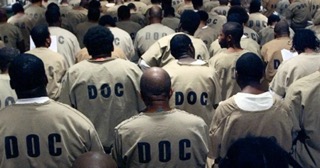By Daniel J. LaLonde
Virginia’s mass incarceration problem started in the late 1960s and early 1970s. In 1925, Virginia’s prison population was 1,920.[1] In 1925, .0008% of Virginia’s population was incarcerated.[2] Between 1925 and 1965, Virginia’s prison population remained relatively steady.[3] If, between 1965 and 2005, the prison population grew at the 1925 to 1965 pace, Virginia’s prison population in 2005 would have only been about 6,400. Instead, in mid-year 2005, Virginia’s prison population was 35,667,[4] over five times the 1925-1965 trend.[5] Amazingly, from 1965 to 2005, Virginia grew its incarcerated population faster than its unincarcerated population. But these facts are hardly a shock in 2023. What society hears less of is the view of mass incarceration from those tasked with administering this program; the Virginia Department of Corrections (“VDOC”). So, in this post, I want to look at what VDOC thought of the mass incarceration problem right as it was beginning.
In 1978, the Secretary of the Department of Public Safety (the department VDOC is under) commissioned a committee to uncover the reasons for and the solutions to the growing number of inmates in Virginia.[6] Corrections Options for the Eighties, the report the committee created, is incredibly insightful because it gives an inside look into how VDOC viewed the problem when it was forming. At the beginning of the report, the committee pointed out that it conducted this study while VDOC was facing a massive increase in prison populations.[7] The committee noted that one of the reasons often cited for rising prison populations is rising crime rates.[8] However, the committee dismissed this factor, arguing that increased crime rates are likely due to improved reporting methods.[9] In fact, the committee argues that when the report was created, crime rates might have been decreasing, pointing out that serious crime decreased by 9% during the first three months of 1977 when comparing those dates to the same time in 1976.[10] Furthermore, the committee argued that historically, crime and incarceration rates are seldom correlated.[11]
Instead, the committee argued that one of the most underestimated factors influencing rising prison populations is a shift in public attitude toward crime and those who commit it.[12] The committee stated that this social fear and the shift to a more punitive response to crime had increased public awareness.[13]
Recognizing that Virginia corrections faced a swelling prison population, the committee identified various criminal justice reasons why the prison population was growing so quickly. Among the reasons was the idea of misdemeanants.[14] The committee noted that in 1976 there were 1,603 misdemeanants admitted into state custody,[15] many of whom were being put away for relatively minor and mostly non-violent offenses.[16] The committee pointed out that most of the offenses included in the label of “misdemeanants” were alcohol and drug-related.[17] In addition, some of the crimes were for simply being homeless.[18] The committee proposed that community social services or probation officers could best deal with most of these offenses.[19]
It appears that even back in 1978, and even from the mouth of the department that benefits most from the incarceration of individuals, the fact that Virginia puts away far too many people for far too many infractions was obvious.
[1] Langan et al., Historical Statistics on Prisoners in State and Federal Institutions, Yearend 1925-86, U.S. Dep’t of Just Bureau of Just. Statistics, at 5 (May 1988), https://www.ojp.gov/pdffiles1/Digitization/111098NCJRS.pdf.
[2] Divide Virginia’s 1925 state population of 2,423,000, Virginia Population 1900-2021, Macrotrends, https://www.macrotrends.net/states/virginia/population#:~:text=The%20population%20of%20Virginia%20in,a%200.47%25%20increase%20from%202017 (last visited Dec. 14, 2022) (scroll down to chart and hover over the year “1925”), by it’s 1925 prison population of 1,920, Langan, supra note 79.
[3] During this period, Virginia’s prison population grew by only 2,633 prisons, up to 4,553. Langan, supra note 1, at 10. Meaning Virginia only added about sixty-six net prisoners a year for forty years. Or, to put it another way, over forty years, Virginia’s prison population only grew by 137% or 3.4% a year.
[4] Paige M. Harrison & Allen J. Beck, Prison and Jail Inmates at Midyear 2005, U.S. Dep’t of Just. Off. of Just. Programs, at 3 (May 2006), https://bjs.ojp.gov/content/pub/pdf/pjim05.pdf.
[5] In contrast to the 1925 prison population numbers, in 2005, almost .5% of Virginia’s population lived behind bars (divide Virginia’s 2005 state population of 7,577,105, Virginia Population 1900-2021, Macrotrends, https://www.macrotrends.net/states/virginia/population#:~:text=The%20population%20of%20Virginia%20in,a%200.47%25%20increase%20from%202017 (last visited Dec. 14, 2022) (scroll down to chart and hover over the year “2005”), by its 2005 prison population of 35,667, Harrison, supra note 4. Up from .0008% in 1925.
[6] Virginia Department of Corrections, Corrections Options for the Eighties (1978).
[7] Virginia Department of Corrections, supra note 6, at 7.
[8] Virginia Department of Corrections, supra note 6, at 11.
[9] Id.
[10] Id.
[11] Id.
[12] Id.
[13] Id. However, the committee argued that prison populations would rise over time yet likely begin to decline by 1995. Virginia Department of Corrections, supra note 6, at 13. Based on the preceding analysis, it is clear that this outcome was not the case.
[14] Virginia Department of Corrections, supra note 6, at 75.
[15] Id.
[16] Id.
[17] Id.
[18] Id.
[19] Id.

